Leading Change: Analyzing Organizational Strategy and Decision Making
VerifiedAdded on 2020/06/04
|13
|3886
|53
Report
AI Summary
This report delves into the crucial aspects of leading change within organizations, focusing on the dynamic business environment and its impact on strategy and operations. It begins with an introduction highlighting the importance of change management for revenue growth and competitive advantage. Task 1 offers a comparative analysis of Starbucks and Costa Coffee, examining how they adapt to external factors, structural changes, and emerging technologies. It also evaluates internal and external drivers of change, such as customer preferences, technological advancements, and governmental policies, and their effects on leadership, team dynamics, and individual behavior. The report then explores measures to minimize the negative impacts of change on organizational behavior, including creating pathways, explaining plans, and fostering employee participation. Task 2 addresses barriers to change and their influence on decision-making, while Task 3 examines various leadership approaches in dealing with change. The report concludes by summarizing key findings and providing references for further study. This comprehensive analysis provides valuable insights into navigating organizational change effectively.
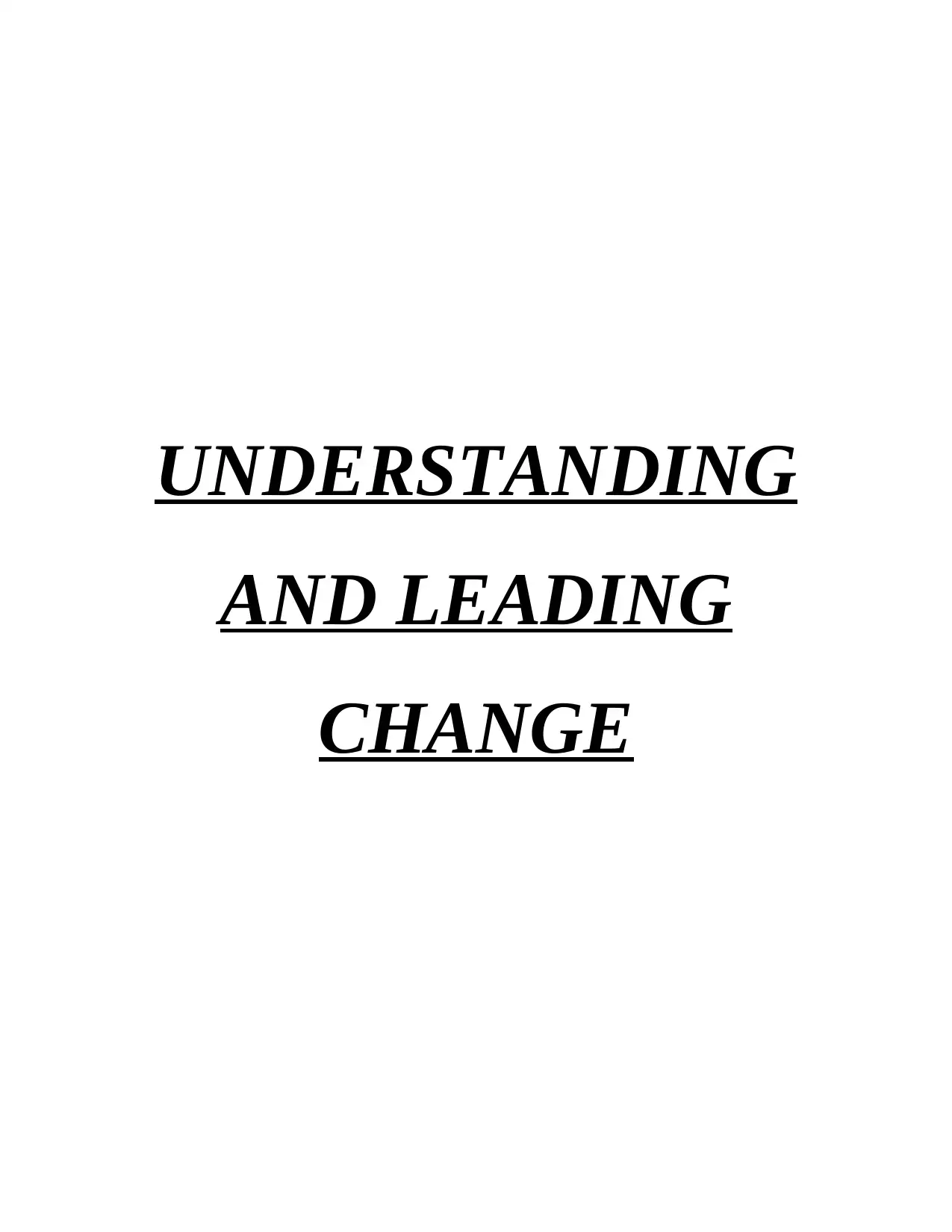
UNDERSTANDING
AND LEADING
CHANGE
AND LEADING
CHANGE
Paraphrase This Document
Need a fresh take? Get an instant paraphrase of this document with our AI Paraphraser
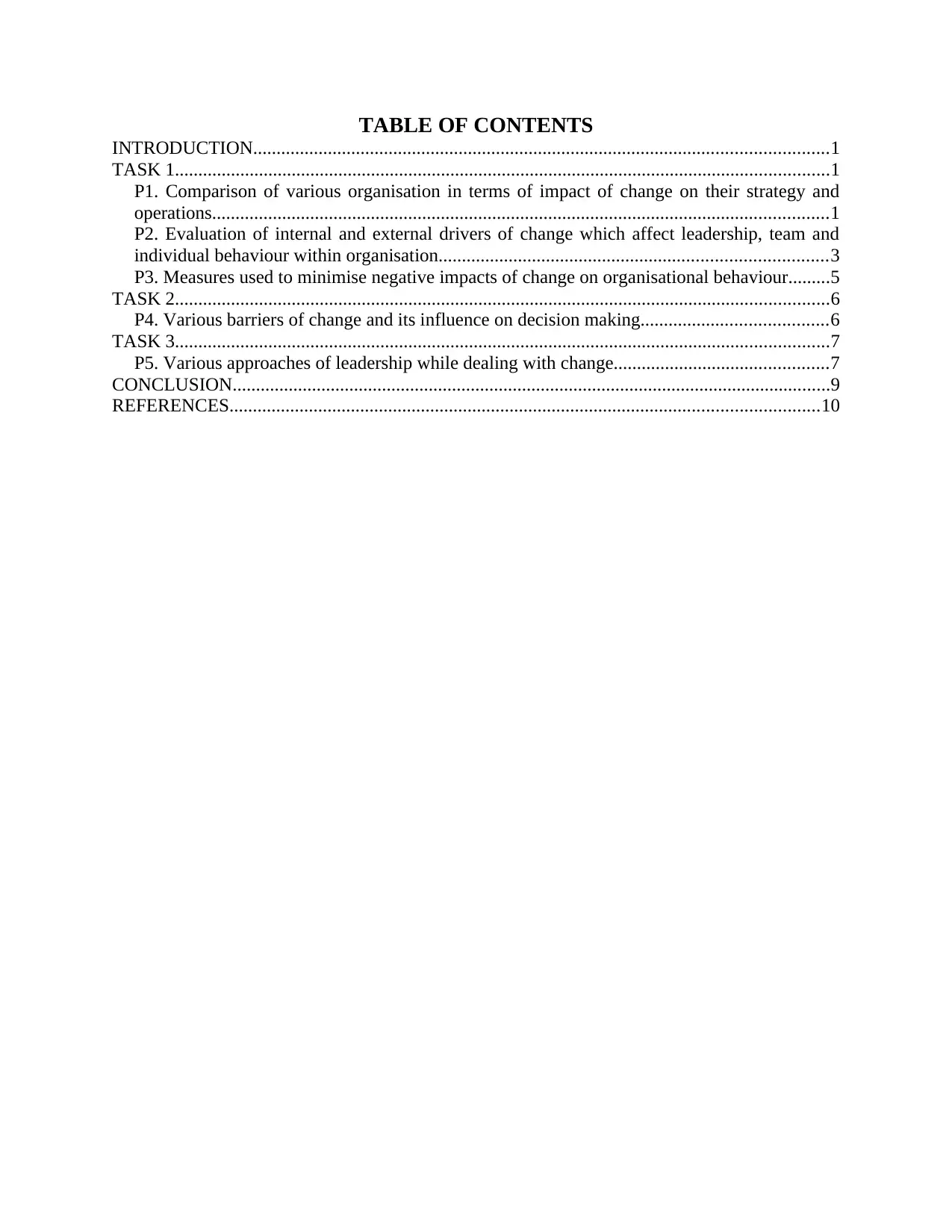
TABLE OF CONTENTS
INTRODUCTION...........................................................................................................................1
TASK 1............................................................................................................................................1
P1. Comparison of various organisation in terms of impact of change on their strategy and
operations....................................................................................................................................1
P2. Evaluation of internal and external drivers of change which affect leadership, team and
individual behaviour within organisation...................................................................................3
P3. Measures used to minimise negative impacts of change on organisational behaviour.........5
TASK 2............................................................................................................................................6
P4. Various barriers of change and its influence on decision making........................................6
TASK 3............................................................................................................................................7
P5. Various approaches of leadership while dealing with change..............................................7
CONCLUSION................................................................................................................................9
REFERENCES..............................................................................................................................10
INTRODUCTION...........................................................................................................................1
TASK 1............................................................................................................................................1
P1. Comparison of various organisation in terms of impact of change on their strategy and
operations....................................................................................................................................1
P2. Evaluation of internal and external drivers of change which affect leadership, team and
individual behaviour within organisation...................................................................................3
P3. Measures used to minimise negative impacts of change on organisational behaviour.........5
TASK 2............................................................................................................................................6
P4. Various barriers of change and its influence on decision making........................................6
TASK 3............................................................................................................................................7
P5. Various approaches of leadership while dealing with change..............................................7
CONCLUSION................................................................................................................................9
REFERENCES..............................................................................................................................10
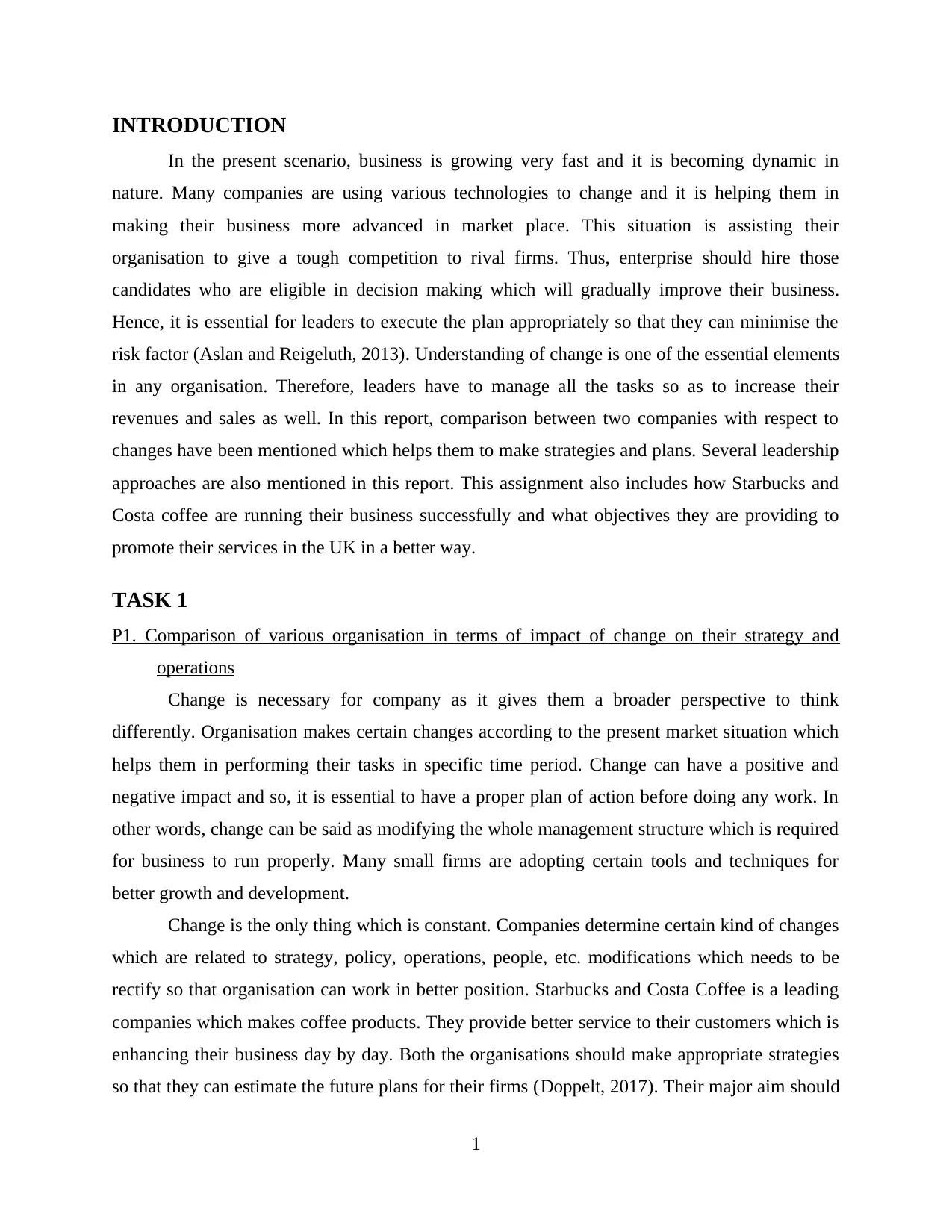
INTRODUCTION
In the present scenario, business is growing very fast and it is becoming dynamic in
nature. Many companies are using various technologies to change and it is helping them in
making their business more advanced in market place. This situation is assisting their
organisation to give a tough competition to rival firms. Thus, enterprise should hire those
candidates who are eligible in decision making which will gradually improve their business.
Hence, it is essential for leaders to execute the plan appropriately so that they can minimise the
risk factor (Aslan and Reigeluth, 2013). Understanding of change is one of the essential elements
in any organisation. Therefore, leaders have to manage all the tasks so as to increase their
revenues and sales as well. In this report, comparison between two companies with respect to
changes have been mentioned which helps them to make strategies and plans. Several leadership
approaches are also mentioned in this report. This assignment also includes how Starbucks and
Costa coffee are running their business successfully and what objectives they are providing to
promote their services in the UK in a better way.
TASK 1
P1. Comparison of various organisation in terms of impact of change on their strategy and
operations
Change is necessary for company as it gives them a broader perspective to think
differently. Organisation makes certain changes according to the present market situation which
helps them in performing their tasks in specific time period. Change can have a positive and
negative impact and so, it is essential to have a proper plan of action before doing any work. In
other words, change can be said as modifying the whole management structure which is required
for business to run properly. Many small firms are adopting certain tools and techniques for
better growth and development.
Change is the only thing which is constant. Companies determine certain kind of changes
which are related to strategy, policy, operations, people, etc. modifications which needs to be
rectify so that organisation can work in better position. Starbucks and Costa Coffee is a leading
companies which makes coffee products. They provide better service to their customers which is
enhancing their business day by day. Both the organisations should make appropriate strategies
so that they can estimate the future plans for their firms (Doppelt, 2017). Their major aim should
1
In the present scenario, business is growing very fast and it is becoming dynamic in
nature. Many companies are using various technologies to change and it is helping them in
making their business more advanced in market place. This situation is assisting their
organisation to give a tough competition to rival firms. Thus, enterprise should hire those
candidates who are eligible in decision making which will gradually improve their business.
Hence, it is essential for leaders to execute the plan appropriately so that they can minimise the
risk factor (Aslan and Reigeluth, 2013). Understanding of change is one of the essential elements
in any organisation. Therefore, leaders have to manage all the tasks so as to increase their
revenues and sales as well. In this report, comparison between two companies with respect to
changes have been mentioned which helps them to make strategies and plans. Several leadership
approaches are also mentioned in this report. This assignment also includes how Starbucks and
Costa coffee are running their business successfully and what objectives they are providing to
promote their services in the UK in a better way.
TASK 1
P1. Comparison of various organisation in terms of impact of change on their strategy and
operations
Change is necessary for company as it gives them a broader perspective to think
differently. Organisation makes certain changes according to the present market situation which
helps them in performing their tasks in specific time period. Change can have a positive and
negative impact and so, it is essential to have a proper plan of action before doing any work. In
other words, change can be said as modifying the whole management structure which is required
for business to run properly. Many small firms are adopting certain tools and techniques for
better growth and development.
Change is the only thing which is constant. Companies determine certain kind of changes
which are related to strategy, policy, operations, people, etc. modifications which needs to be
rectify so that organisation can work in better position. Starbucks and Costa Coffee is a leading
companies which makes coffee products. They provide better service to their customers which is
enhancing their business day by day. Both the organisations should make appropriate strategies
so that they can estimate the future plans for their firms (Doppelt, 2017). Their major aim should
1
⊘ This is a preview!⊘
Do you want full access?
Subscribe today to unlock all pages.

Trusted by 1+ million students worldwide
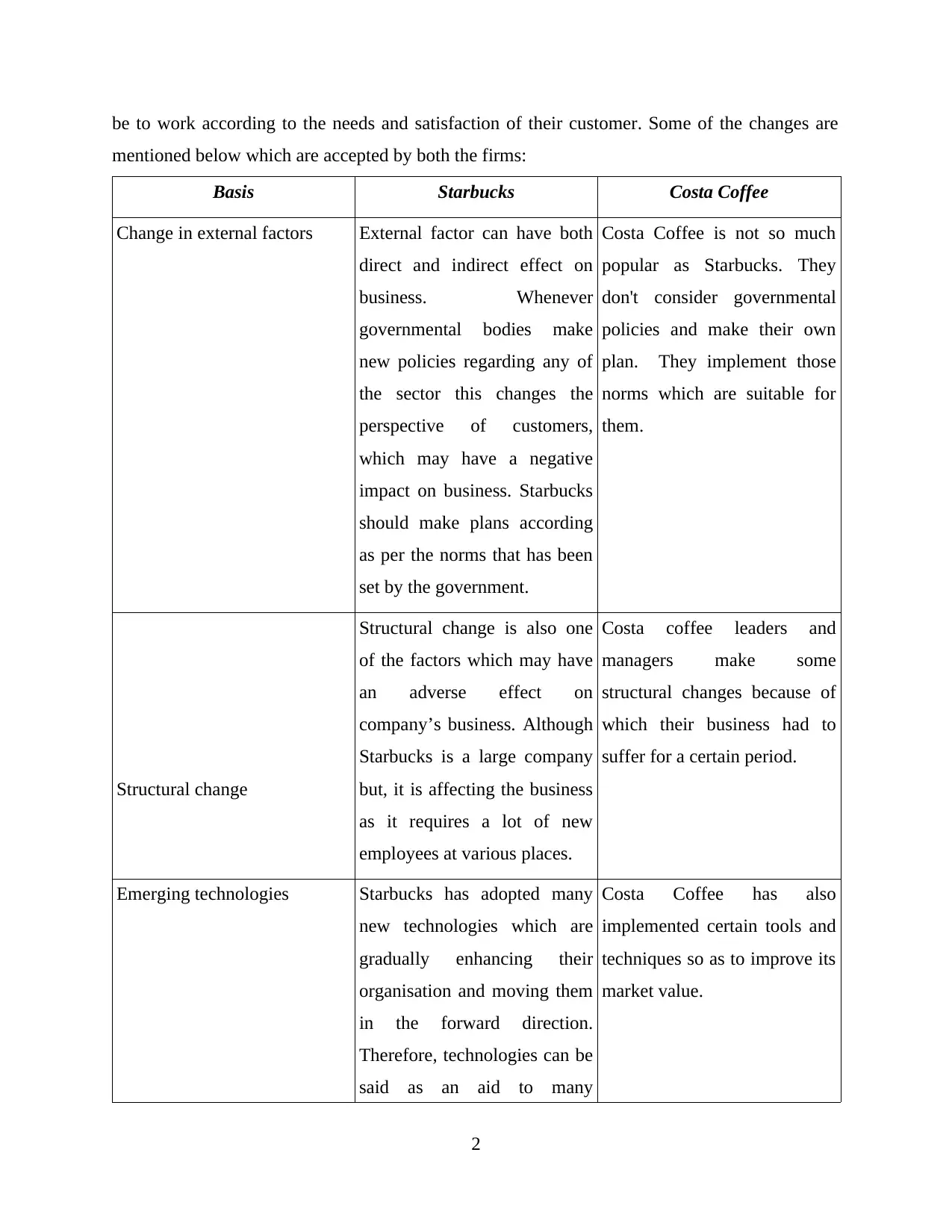
be to work according to the needs and satisfaction of their customer. Some of the changes are
mentioned below which are accepted by both the firms:
Basis Starbucks Costa Coffee
Change in external factors External factor can have both
direct and indirect effect on
business. Whenever
governmental bodies make
new policies regarding any of
the sector this changes the
perspective of customers,
which may have a negative
impact on business. Starbucks
should make plans according
as per the norms that has been
set by the government.
Costa Coffee is not so much
popular as Starbucks. They
don't consider governmental
policies and make their own
plan. They implement those
norms which are suitable for
them.
Structural change
Structural change is also one
of the factors which may have
an adverse effect on
company’s business. Although
Starbucks is a large company
but, it is affecting the business
as it requires a lot of new
employees at various places.
Costa coffee leaders and
managers make some
structural changes because of
which their business had to
suffer for a certain period.
Emerging technologies Starbucks has adopted many
new technologies which are
gradually enhancing their
organisation and moving them
in the forward direction.
Therefore, technologies can be
said as an aid to many
Costa Coffee has also
implemented certain tools and
techniques so as to improve its
market value.
2
mentioned below which are accepted by both the firms:
Basis Starbucks Costa Coffee
Change in external factors External factor can have both
direct and indirect effect on
business. Whenever
governmental bodies make
new policies regarding any of
the sector this changes the
perspective of customers,
which may have a negative
impact on business. Starbucks
should make plans according
as per the norms that has been
set by the government.
Costa Coffee is not so much
popular as Starbucks. They
don't consider governmental
policies and make their own
plan. They implement those
norms which are suitable for
them.
Structural change
Structural change is also one
of the factors which may have
an adverse effect on
company’s business. Although
Starbucks is a large company
but, it is affecting the business
as it requires a lot of new
employees at various places.
Costa coffee leaders and
managers make some
structural changes because of
which their business had to
suffer for a certain period.
Emerging technologies Starbucks has adopted many
new technologies which are
gradually enhancing their
organisation and moving them
in the forward direction.
Therefore, technologies can be
said as an aid to many
Costa Coffee has also
implemented certain tools and
techniques so as to improve its
market value.
2
Paraphrase This Document
Need a fresh take? Get an instant paraphrase of this document with our AI Paraphraser
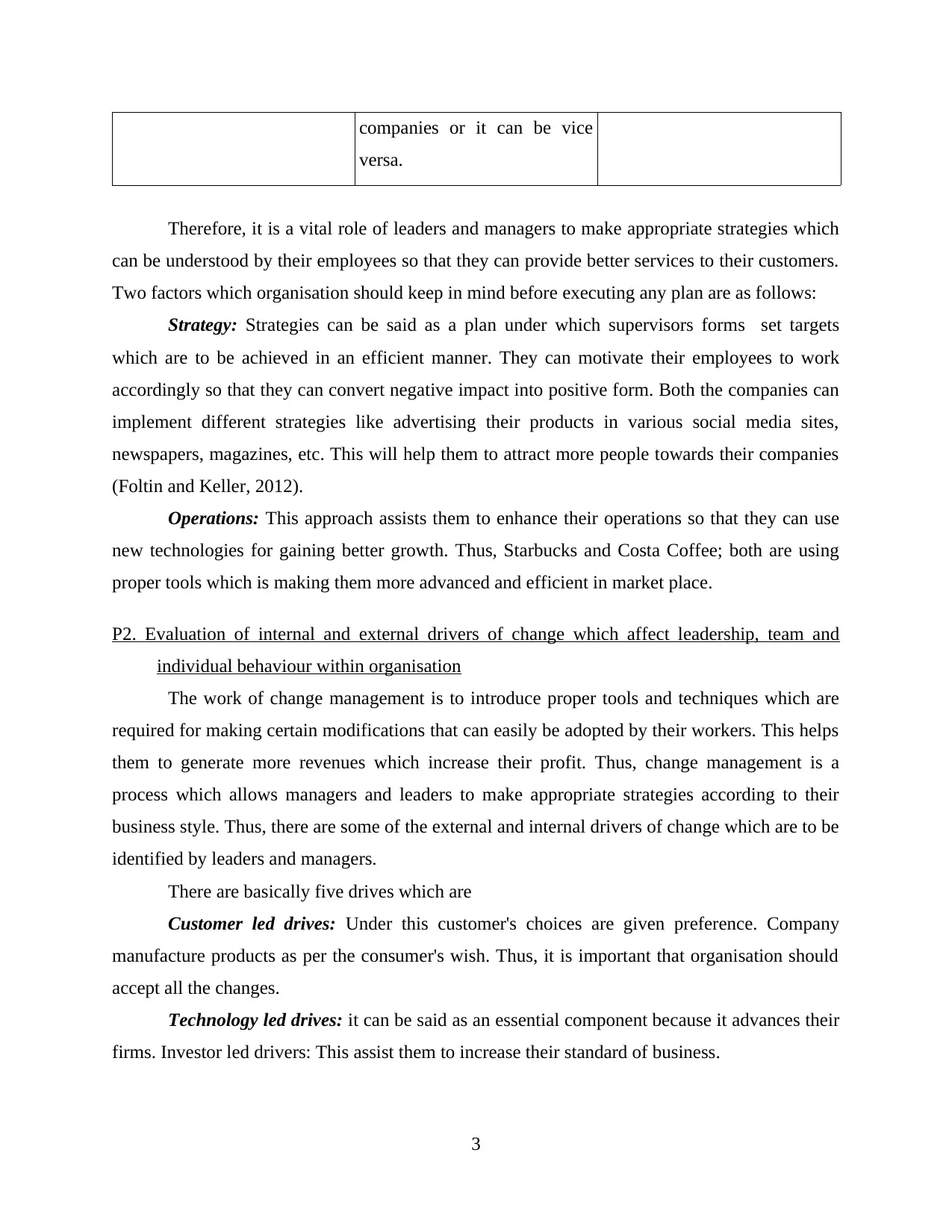
companies or it can be vice
versa.
Therefore, it is a vital role of leaders and managers to make appropriate strategies which
can be understood by their employees so that they can provide better services to their customers.
Two factors which organisation should keep in mind before executing any plan are as follows:
Strategy: Strategies can be said as a plan under which supervisors forms set targets
which are to be achieved in an efficient manner. They can motivate their employees to work
accordingly so that they can convert negative impact into positive form. Both the companies can
implement different strategies like advertising their products in various social media sites,
newspapers, magazines, etc. This will help them to attract more people towards their companies
(Foltin and Keller, 2012).
Operations: This approach assists them to enhance their operations so that they can use
new technologies for gaining better growth. Thus, Starbucks and Costa Coffee; both are using
proper tools which is making them more advanced and efficient in market place.
P2. Evaluation of internal and external drivers of change which affect leadership, team and
individual behaviour within organisation
The work of change management is to introduce proper tools and techniques which are
required for making certain modifications that can easily be adopted by their workers. This helps
them to generate more revenues which increase their profit. Thus, change management is a
process which allows managers and leaders to make appropriate strategies according to their
business style. Thus, there are some of the external and internal drivers of change which are to be
identified by leaders and managers.
There are basically five drives which are
Customer led drives: Under this customer's choices are given preference. Company
manufacture products as per the consumer's wish. Thus, it is important that organisation should
accept all the changes.
Technology led drives: it can be said as an essential component because it advances their
firms. Investor led drivers: This assist them to increase their standard of business.
3
versa.
Therefore, it is a vital role of leaders and managers to make appropriate strategies which
can be understood by their employees so that they can provide better services to their customers.
Two factors which organisation should keep in mind before executing any plan are as follows:
Strategy: Strategies can be said as a plan under which supervisors forms set targets
which are to be achieved in an efficient manner. They can motivate their employees to work
accordingly so that they can convert negative impact into positive form. Both the companies can
implement different strategies like advertising their products in various social media sites,
newspapers, magazines, etc. This will help them to attract more people towards their companies
(Foltin and Keller, 2012).
Operations: This approach assists them to enhance their operations so that they can use
new technologies for gaining better growth. Thus, Starbucks and Costa Coffee; both are using
proper tools which is making them more advanced and efficient in market place.
P2. Evaluation of internal and external drivers of change which affect leadership, team and
individual behaviour within organisation
The work of change management is to introduce proper tools and techniques which are
required for making certain modifications that can easily be adopted by their workers. This helps
them to generate more revenues which increase their profit. Thus, change management is a
process which allows managers and leaders to make appropriate strategies according to their
business style. Thus, there are some of the external and internal drivers of change which are to be
identified by leaders and managers.
There are basically five drives which are
Customer led drives: Under this customer's choices are given preference. Company
manufacture products as per the consumer's wish. Thus, it is important that organisation should
accept all the changes.
Technology led drives: it can be said as an essential component because it advances their
firms. Investor led drivers: This assist them to increase their standard of business.
3
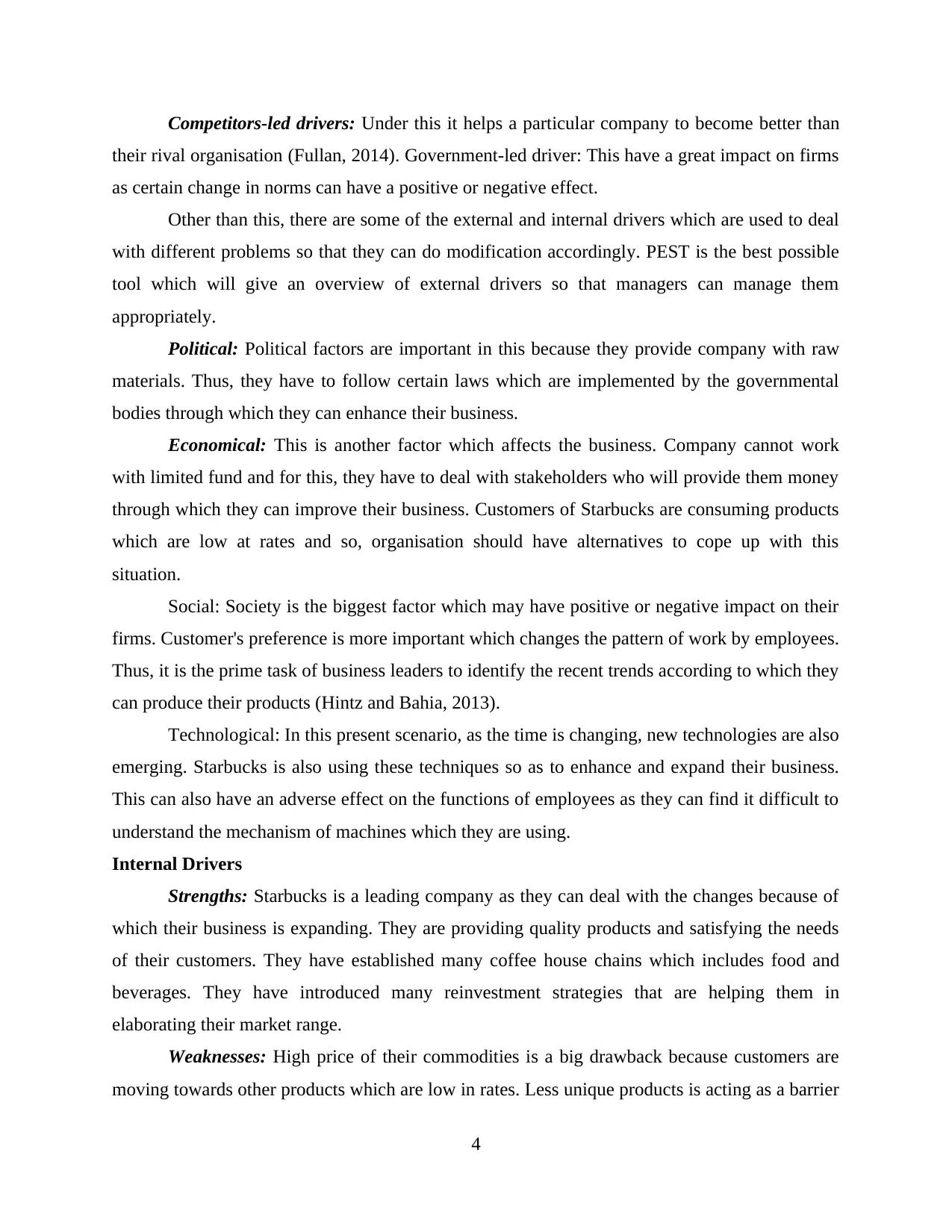
Competitors-led drivers: Under this it helps a particular company to become better than
their rival organisation (Fullan, 2014). Government-led driver: This have a great impact on firms
as certain change in norms can have a positive or negative effect.
Other than this, there are some of the external and internal drivers which are used to deal
with different problems so that they can do modification accordingly. PEST is the best possible
tool which will give an overview of external drivers so that managers can manage them
appropriately.
Political: Political factors are important in this because they provide company with raw
materials. Thus, they have to follow certain laws which are implemented by the governmental
bodies through which they can enhance their business.
Economical: This is another factor which affects the business. Company cannot work
with limited fund and for this, they have to deal with stakeholders who will provide them money
through which they can improve their business. Customers of Starbucks are consuming products
which are low at rates and so, organisation should have alternatives to cope up with this
situation.
Social: Society is the biggest factor which may have positive or negative impact on their
firms. Customer's preference is more important which changes the pattern of work by employees.
Thus, it is the prime task of business leaders to identify the recent trends according to which they
can produce their products (Hintz and Bahia, 2013).
Technological: In this present scenario, as the time is changing, new technologies are also
emerging. Starbucks is also using these techniques so as to enhance and expand their business.
This can also have an adverse effect on the functions of employees as they can find it difficult to
understand the mechanism of machines which they are using.
Internal Drivers
Strengths: Starbucks is a leading company as they can deal with the changes because of
which their business is expanding. They are providing quality products and satisfying the needs
of their customers. They have established many coffee house chains which includes food and
beverages. They have introduced many reinvestment strategies that are helping them in
elaborating their market range.
Weaknesses: High price of their commodities is a big drawback because customers are
moving towards other products which are low in rates. Less unique products is acting as a barrier
4
their rival organisation (Fullan, 2014). Government-led driver: This have a great impact on firms
as certain change in norms can have a positive or negative effect.
Other than this, there are some of the external and internal drivers which are used to deal
with different problems so that they can do modification accordingly. PEST is the best possible
tool which will give an overview of external drivers so that managers can manage them
appropriately.
Political: Political factors are important in this because they provide company with raw
materials. Thus, they have to follow certain laws which are implemented by the governmental
bodies through which they can enhance their business.
Economical: This is another factor which affects the business. Company cannot work
with limited fund and for this, they have to deal with stakeholders who will provide them money
through which they can improve their business. Customers of Starbucks are consuming products
which are low at rates and so, organisation should have alternatives to cope up with this
situation.
Social: Society is the biggest factor which may have positive or negative impact on their
firms. Customer's preference is more important which changes the pattern of work by employees.
Thus, it is the prime task of business leaders to identify the recent trends according to which they
can produce their products (Hintz and Bahia, 2013).
Technological: In this present scenario, as the time is changing, new technologies are also
emerging. Starbucks is also using these techniques so as to enhance and expand their business.
This can also have an adverse effect on the functions of employees as they can find it difficult to
understand the mechanism of machines which they are using.
Internal Drivers
Strengths: Starbucks is a leading company as they can deal with the changes because of
which their business is expanding. They are providing quality products and satisfying the needs
of their customers. They have established many coffee house chains which includes food and
beverages. They have introduced many reinvestment strategies that are helping them in
elaborating their market range.
Weaknesses: High price of their commodities is a big drawback because customers are
moving towards other products which are low in rates. Less unique products is acting as a barrier
4
⊘ This is a preview!⊘
Do you want full access?
Subscribe today to unlock all pages.

Trusted by 1+ million students worldwide
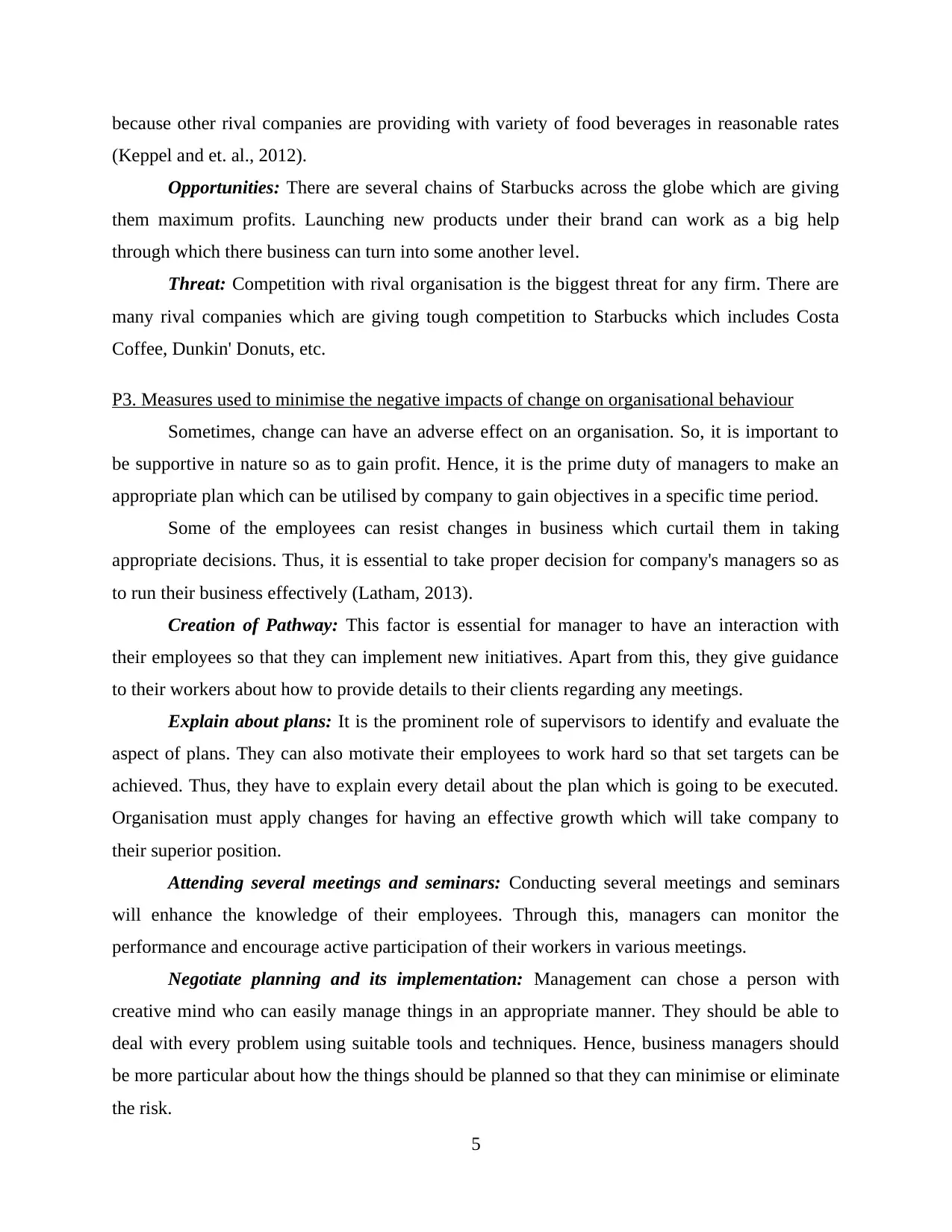
because other rival companies are providing with variety of food beverages in reasonable rates
(Keppel and et. al., 2012).
Opportunities: There are several chains of Starbucks across the globe which are giving
them maximum profits. Launching new products under their brand can work as a big help
through which there business can turn into some another level.
Threat: Competition with rival organisation is the biggest threat for any firm. There are
many rival companies which are giving tough competition to Starbucks which includes Costa
Coffee, Dunkin' Donuts, etc.
P3. Measures used to minimise the negative impacts of change on organisational behaviour
Sometimes, change can have an adverse effect on an organisation. So, it is important to
be supportive in nature so as to gain profit. Hence, it is the prime duty of managers to make an
appropriate plan which can be utilised by company to gain objectives in a specific time period.
Some of the employees can resist changes in business which curtail them in taking
appropriate decisions. Thus, it is essential to take proper decision for company's managers so as
to run their business effectively (Latham, 2013).
Creation of Pathway: This factor is essential for manager to have an interaction with
their employees so that they can implement new initiatives. Apart from this, they give guidance
to their workers about how to provide details to their clients regarding any meetings.
Explain about plans: It is the prominent role of supervisors to identify and evaluate the
aspect of plans. They can also motivate their employees to work hard so that set targets can be
achieved. Thus, they have to explain every detail about the plan which is going to be executed.
Organisation must apply changes for having an effective growth which will take company to
their superior position.
Attending several meetings and seminars: Conducting several meetings and seminars
will enhance the knowledge of their employees. Through this, managers can monitor the
performance and encourage active participation of their workers in various meetings.
Negotiate planning and its implementation: Management can chose a person with
creative mind who can easily manage things in an appropriate manner. They should be able to
deal with every problem using suitable tools and techniques. Hence, business managers should
be more particular about how the things should be planned so that they can minimise or eliminate
the risk.
5
(Keppel and et. al., 2012).
Opportunities: There are several chains of Starbucks across the globe which are giving
them maximum profits. Launching new products under their brand can work as a big help
through which there business can turn into some another level.
Threat: Competition with rival organisation is the biggest threat for any firm. There are
many rival companies which are giving tough competition to Starbucks which includes Costa
Coffee, Dunkin' Donuts, etc.
P3. Measures used to minimise the negative impacts of change on organisational behaviour
Sometimes, change can have an adverse effect on an organisation. So, it is important to
be supportive in nature so as to gain profit. Hence, it is the prime duty of managers to make an
appropriate plan which can be utilised by company to gain objectives in a specific time period.
Some of the employees can resist changes in business which curtail them in taking
appropriate decisions. Thus, it is essential to take proper decision for company's managers so as
to run their business effectively (Latham, 2013).
Creation of Pathway: This factor is essential for manager to have an interaction with
their employees so that they can implement new initiatives. Apart from this, they give guidance
to their workers about how to provide details to their clients regarding any meetings.
Explain about plans: It is the prominent role of supervisors to identify and evaluate the
aspect of plans. They can also motivate their employees to work hard so that set targets can be
achieved. Thus, they have to explain every detail about the plan which is going to be executed.
Organisation must apply changes for having an effective growth which will take company to
their superior position.
Attending several meetings and seminars: Conducting several meetings and seminars
will enhance the knowledge of their employees. Through this, managers can monitor the
performance and encourage active participation of their workers in various meetings.
Negotiate planning and its implementation: Management can chose a person with
creative mind who can easily manage things in an appropriate manner. They should be able to
deal with every problem using suitable tools and techniques. Hence, business managers should
be more particular about how the things should be planned so that they can minimise or eliminate
the risk.
5
Paraphrase This Document
Need a fresh take? Get an instant paraphrase of this document with our AI Paraphraser
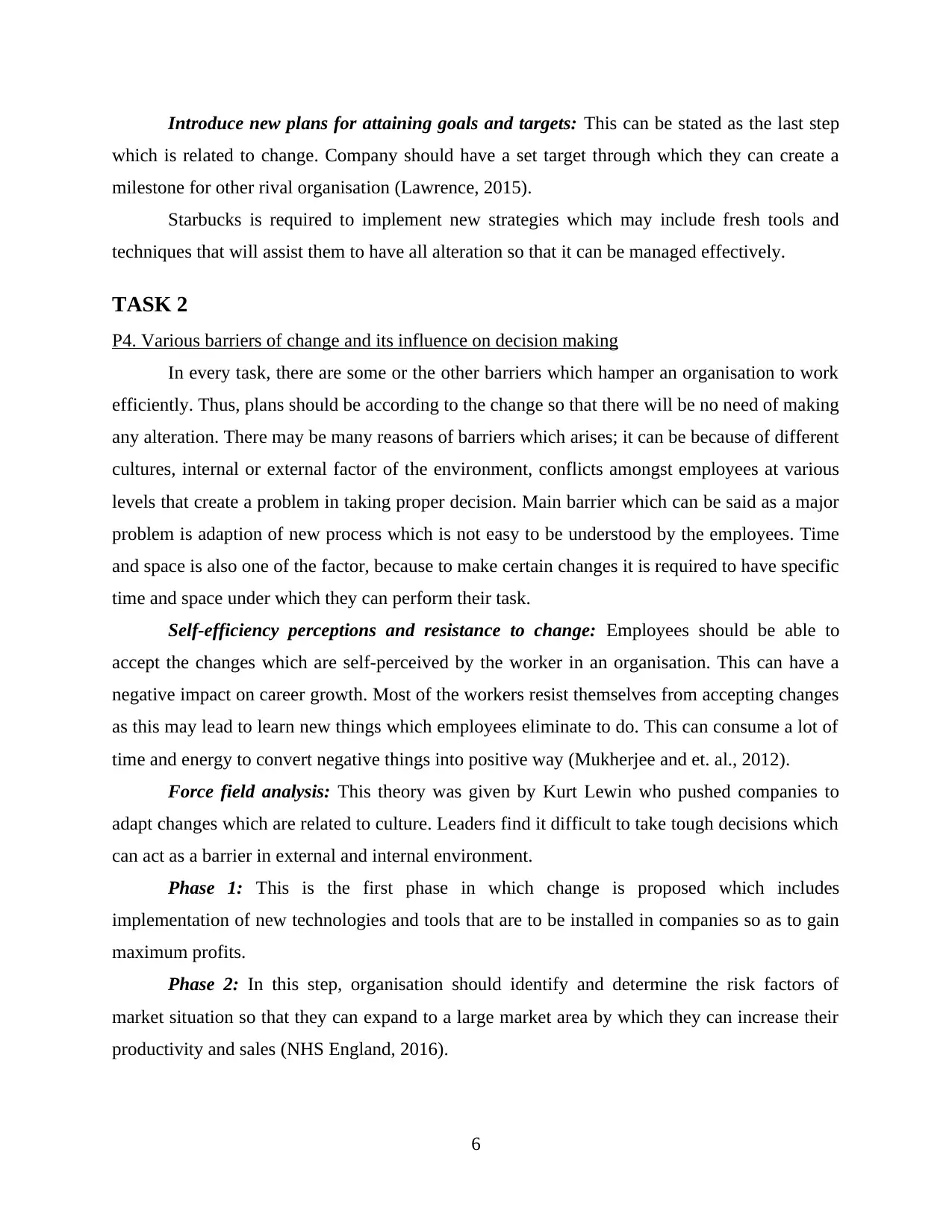
Introduce new plans for attaining goals and targets: This can be stated as the last step
which is related to change. Company should have a set target through which they can create a
milestone for other rival organisation (Lawrence, 2015).
Starbucks is required to implement new strategies which may include fresh tools and
techniques that will assist them to have all alteration so that it can be managed effectively.
TASK 2
P4. Various barriers of change and its influence on decision making
In every task, there are some or the other barriers which hamper an organisation to work
efficiently. Thus, plans should be according to the change so that there will be no need of making
any alteration. There may be many reasons of barriers which arises; it can be because of different
cultures, internal or external factor of the environment, conflicts amongst employees at various
levels that create a problem in taking proper decision. Main barrier which can be said as a major
problem is adaption of new process which is not easy to be understood by the employees. Time
and space is also one of the factor, because to make certain changes it is required to have specific
time and space under which they can perform their task.
Self-efficiency perceptions and resistance to change: Employees should be able to
accept the changes which are self-perceived by the worker in an organisation. This can have a
negative impact on career growth. Most of the workers resist themselves from accepting changes
as this may lead to learn new things which employees eliminate to do. This can consume a lot of
time and energy to convert negative things into positive way (Mukherjee and et. al., 2012).
Force field analysis: This theory was given by Kurt Lewin who pushed companies to
adapt changes which are related to culture. Leaders find it difficult to take tough decisions which
can act as a barrier in external and internal environment.
Phase 1: This is the first phase in which change is proposed which includes
implementation of new technologies and tools that are to be installed in companies so as to gain
maximum profits.
Phase 2: In this step, organisation should identify and determine the risk factors of
market situation so that they can expand to a large market area by which they can increase their
productivity and sales (NHS England, 2016).
6
which is related to change. Company should have a set target through which they can create a
milestone for other rival organisation (Lawrence, 2015).
Starbucks is required to implement new strategies which may include fresh tools and
techniques that will assist them to have all alteration so that it can be managed effectively.
TASK 2
P4. Various barriers of change and its influence on decision making
In every task, there are some or the other barriers which hamper an organisation to work
efficiently. Thus, plans should be according to the change so that there will be no need of making
any alteration. There may be many reasons of barriers which arises; it can be because of different
cultures, internal or external factor of the environment, conflicts amongst employees at various
levels that create a problem in taking proper decision. Main barrier which can be said as a major
problem is adaption of new process which is not easy to be understood by the employees. Time
and space is also one of the factor, because to make certain changes it is required to have specific
time and space under which they can perform their task.
Self-efficiency perceptions and resistance to change: Employees should be able to
accept the changes which are self-perceived by the worker in an organisation. This can have a
negative impact on career growth. Most of the workers resist themselves from accepting changes
as this may lead to learn new things which employees eliminate to do. This can consume a lot of
time and energy to convert negative things into positive way (Mukherjee and et. al., 2012).
Force field analysis: This theory was given by Kurt Lewin who pushed companies to
adapt changes which are related to culture. Leaders find it difficult to take tough decisions which
can act as a barrier in external and internal environment.
Phase 1: This is the first phase in which change is proposed which includes
implementation of new technologies and tools that are to be installed in companies so as to gain
maximum profits.
Phase 2: In this step, organisation should identify and determine the risk factors of
market situation so that they can expand to a large market area by which they can increase their
productivity and sales (NHS England, 2016).
6
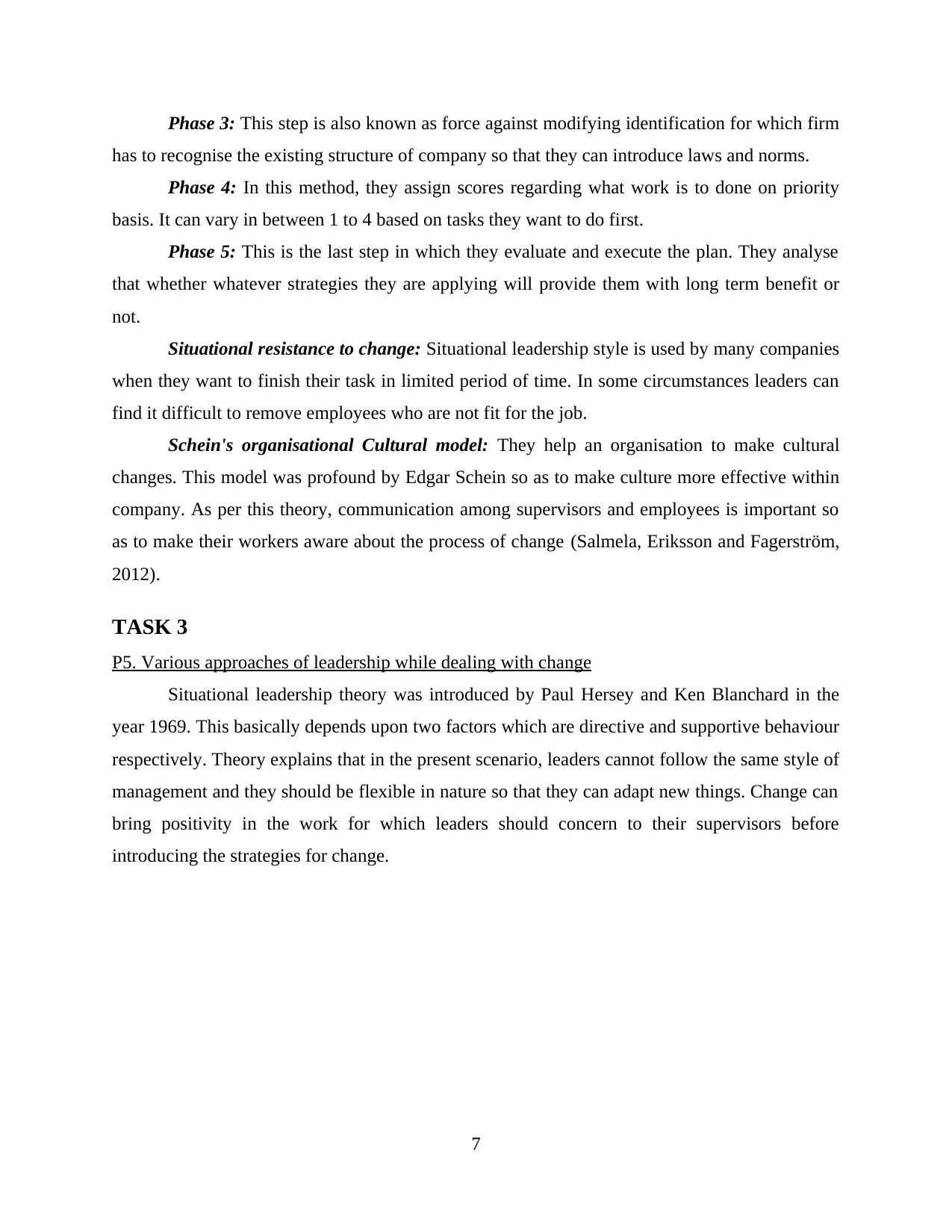
Phase 3: This step is also known as force against modifying identification for which firm
has to recognise the existing structure of company so that they can introduce laws and norms.
Phase 4: In this method, they assign scores regarding what work is to done on priority
basis. It can vary in between 1 to 4 based on tasks they want to do first.
Phase 5: This is the last step in which they evaluate and execute the plan. They analyse
that whether whatever strategies they are applying will provide them with long term benefit or
not.
Situational resistance to change: Situational leadership style is used by many companies
when they want to finish their task in limited period of time. In some circumstances leaders can
find it difficult to remove employees who are not fit for the job.
Schein's organisational Cultural model: They help an organisation to make cultural
changes. This model was profound by Edgar Schein so as to make culture more effective within
company. As per this theory, communication among supervisors and employees is important so
as to make their workers aware about the process of change (Salmela, Eriksson and Fagerström,
2012).
TASK 3
P5. Various approaches of leadership while dealing with change
Situational leadership theory was introduced by Paul Hersey and Ken Blanchard in the
year 1969. This basically depends upon two factors which are directive and supportive behaviour
respectively. Theory explains that in the present scenario, leaders cannot follow the same style of
management and they should be flexible in nature so that they can adapt new things. Change can
bring positivity in the work for which leaders should concern to their supervisors before
introducing the strategies for change.
7
has to recognise the existing structure of company so that they can introduce laws and norms.
Phase 4: In this method, they assign scores regarding what work is to done on priority
basis. It can vary in between 1 to 4 based on tasks they want to do first.
Phase 5: This is the last step in which they evaluate and execute the plan. They analyse
that whether whatever strategies they are applying will provide them with long term benefit or
not.
Situational resistance to change: Situational leadership style is used by many companies
when they want to finish their task in limited period of time. In some circumstances leaders can
find it difficult to remove employees who are not fit for the job.
Schein's organisational Cultural model: They help an organisation to make cultural
changes. This model was profound by Edgar Schein so as to make culture more effective within
company. As per this theory, communication among supervisors and employees is important so
as to make their workers aware about the process of change (Salmela, Eriksson and Fagerström,
2012).
TASK 3
P5. Various approaches of leadership while dealing with change
Situational leadership theory was introduced by Paul Hersey and Ken Blanchard in the
year 1969. This basically depends upon two factors which are directive and supportive behaviour
respectively. Theory explains that in the present scenario, leaders cannot follow the same style of
management and they should be flexible in nature so that they can adapt new things. Change can
bring positivity in the work for which leaders should concern to their supervisors before
introducing the strategies for change.
7
⊘ This is a preview!⊘
Do you want full access?
Subscribe today to unlock all pages.

Trusted by 1+ million students worldwide
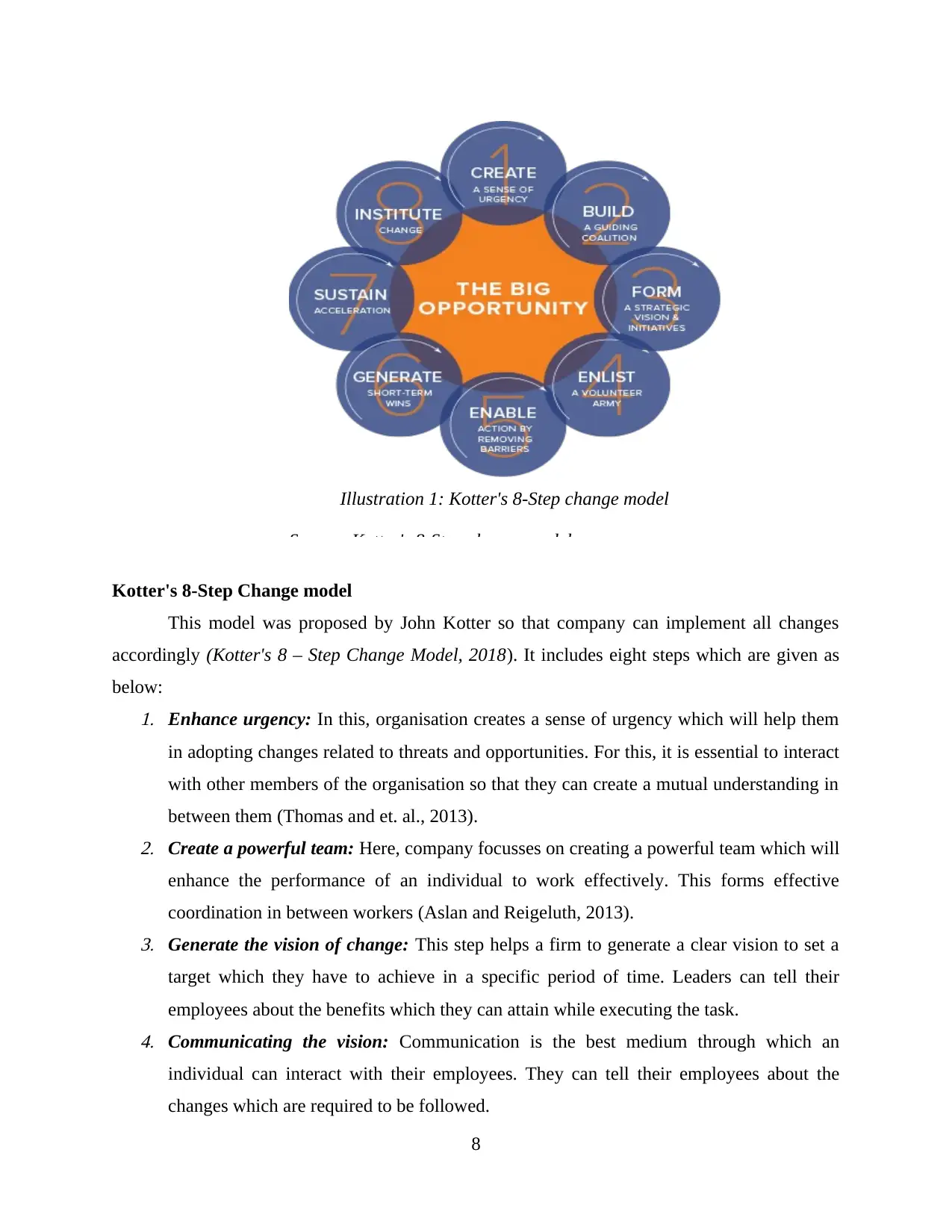
Kotter's 8-Step Change model
This model was proposed by John Kotter so that company can implement all changes
accordingly (Kotter's 8 – Step Change Model, 2018). It includes eight steps which are given as
below:1. Enhance urgency: In this, organisation creates a sense of urgency which will help them
in adopting changes related to threats and opportunities. For this, it is essential to interact
with other members of the organisation so that they can create a mutual understanding in
between them (Thomas and et. al., 2013).2. Create a powerful team: Here, company focusses on creating a powerful team which will
enhance the performance of an individual to work effectively. This forms effective
coordination in between workers (Aslan and Reigeluth, 2013).3. Generate the vision of change: This step helps a firm to generate a clear vision to set a
target which they have to achieve in a specific period of time. Leaders can tell their
employees about the benefits which they can attain while executing the task.4. Communicating the vision: Communication is the best medium through which an
individual can interact with their employees. They can tell their employees about the
changes which are required to be followed.
8
Illustration 1: Kotter's 8-Step change model
Source: Kotter's 8-Step change model
This model was proposed by John Kotter so that company can implement all changes
accordingly (Kotter's 8 – Step Change Model, 2018). It includes eight steps which are given as
below:1. Enhance urgency: In this, organisation creates a sense of urgency which will help them
in adopting changes related to threats and opportunities. For this, it is essential to interact
with other members of the organisation so that they can create a mutual understanding in
between them (Thomas and et. al., 2013).2. Create a powerful team: Here, company focusses on creating a powerful team which will
enhance the performance of an individual to work effectively. This forms effective
coordination in between workers (Aslan and Reigeluth, 2013).3. Generate the vision of change: This step helps a firm to generate a clear vision to set a
target which they have to achieve in a specific period of time. Leaders can tell their
employees about the benefits which they can attain while executing the task.4. Communicating the vision: Communication is the best medium through which an
individual can interact with their employees. They can tell their employees about the
changes which are required to be followed.
8
Illustration 1: Kotter's 8-Step change model
Source: Kotter's 8-Step change model
Paraphrase This Document
Need a fresh take? Get an instant paraphrase of this document with our AI Paraphraser
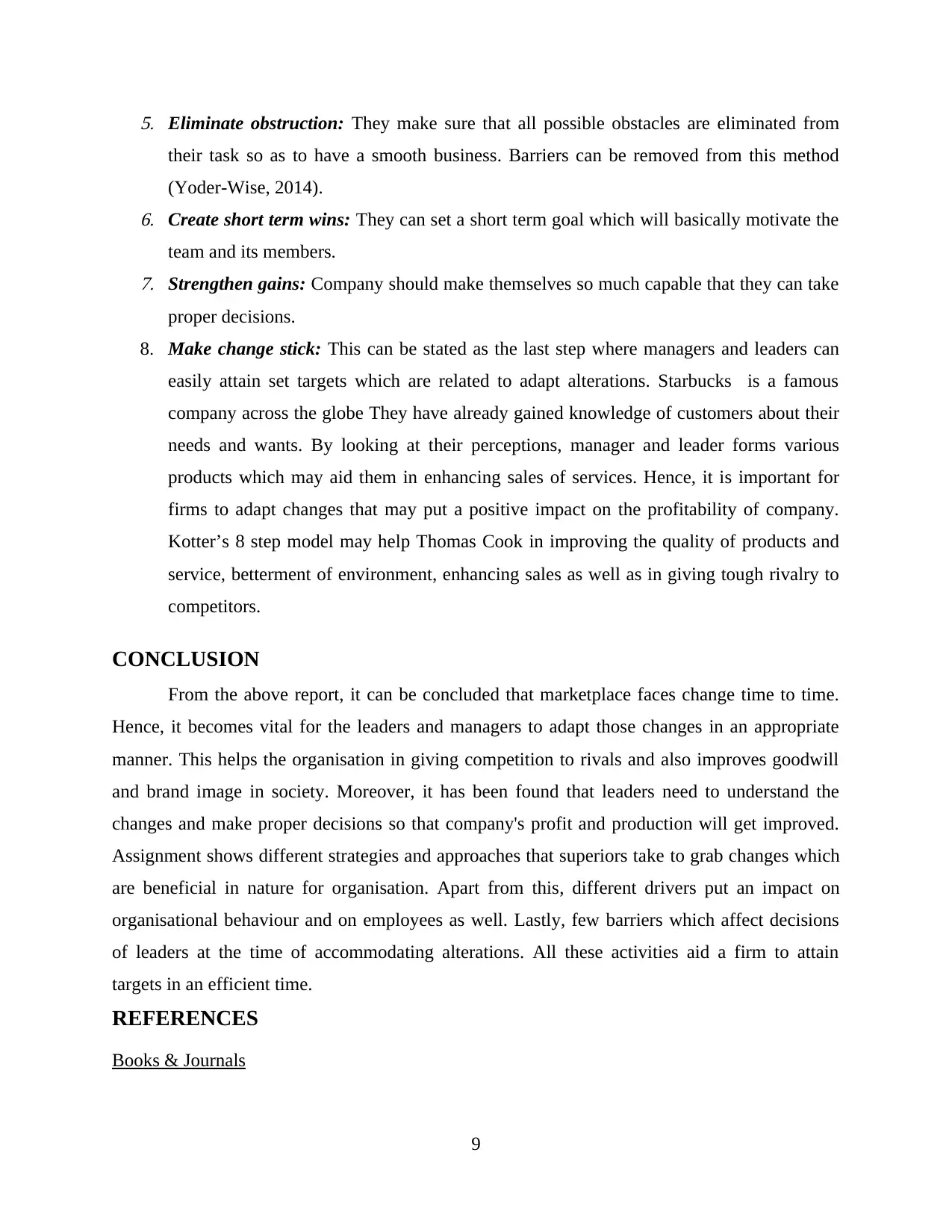
5. Eliminate obstruction: They make sure that all possible obstacles are eliminated from
their task so as to have a smooth business. Barriers can be removed from this method
(Yoder-Wise, 2014).6. Create short term wins: They can set a short term goal which will basically motivate the
team and its members.7. Strengthen gains: Company should make themselves so much capable that they can take
proper decisions.
8. Make change stick: This can be stated as the last step where managers and leaders can
easily attain set targets which are related to adapt alterations. Starbucks is a famous
company across the globe They have already gained knowledge of customers about their
needs and wants. By looking at their perceptions, manager and leader forms various
products which may aid them in enhancing sales of services. Hence, it is important for
firms to adapt changes that may put a positive impact on the profitability of company.
Kotter’s 8 step model may help Thomas Cook in improving the quality of products and
service, betterment of environment, enhancing sales as well as in giving tough rivalry to
competitors.
CONCLUSION
From the above report, it can be concluded that marketplace faces change time to time.
Hence, it becomes vital for the leaders and managers to adapt those changes in an appropriate
manner. This helps the organisation in giving competition to rivals and also improves goodwill
and brand image in society. Moreover, it has been found that leaders need to understand the
changes and make proper decisions so that company's profit and production will get improved.
Assignment shows different strategies and approaches that superiors take to grab changes which
are beneficial in nature for organisation. Apart from this, different drivers put an impact on
organisational behaviour and on employees as well. Lastly, few barriers which affect decisions
of leaders at the time of accommodating alterations. All these activities aid a firm to attain
targets in an efficient time.
REFERENCES
Books & Journals
9
their task so as to have a smooth business. Barriers can be removed from this method
(Yoder-Wise, 2014).6. Create short term wins: They can set a short term goal which will basically motivate the
team and its members.7. Strengthen gains: Company should make themselves so much capable that they can take
proper decisions.
8. Make change stick: This can be stated as the last step where managers and leaders can
easily attain set targets which are related to adapt alterations. Starbucks is a famous
company across the globe They have already gained knowledge of customers about their
needs and wants. By looking at their perceptions, manager and leader forms various
products which may aid them in enhancing sales of services. Hence, it is important for
firms to adapt changes that may put a positive impact on the profitability of company.
Kotter’s 8 step model may help Thomas Cook in improving the quality of products and
service, betterment of environment, enhancing sales as well as in giving tough rivalry to
competitors.
CONCLUSION
From the above report, it can be concluded that marketplace faces change time to time.
Hence, it becomes vital for the leaders and managers to adapt those changes in an appropriate
manner. This helps the organisation in giving competition to rivals and also improves goodwill
and brand image in society. Moreover, it has been found that leaders need to understand the
changes and make proper decisions so that company's profit and production will get improved.
Assignment shows different strategies and approaches that superiors take to grab changes which
are beneficial in nature for organisation. Apart from this, different drivers put an impact on
organisational behaviour and on employees as well. Lastly, few barriers which affect decisions
of leaders at the time of accommodating alterations. All these activities aid a firm to attain
targets in an efficient time.
REFERENCES
Books & Journals
9
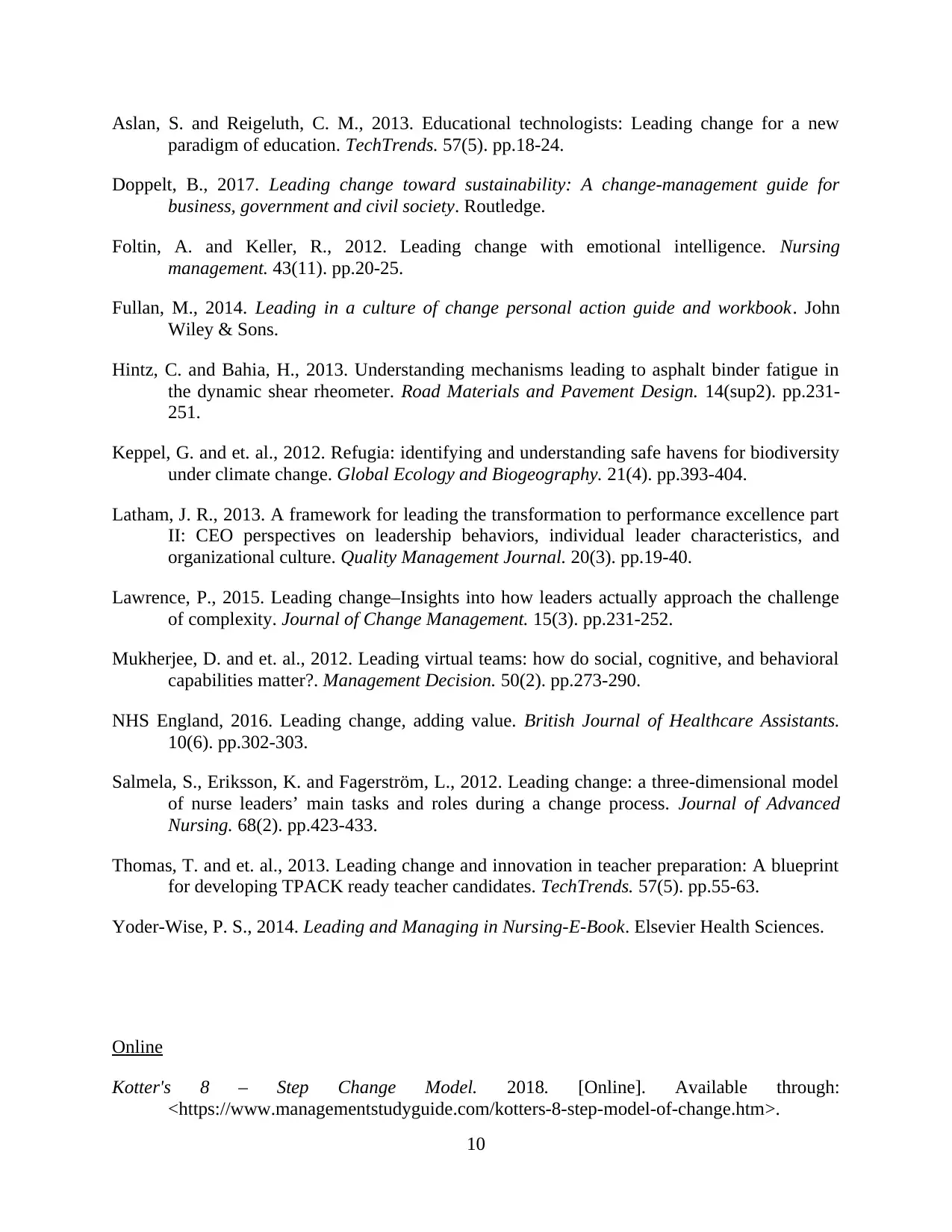
Aslan, S. and Reigeluth, C. M., 2013. Educational technologists: Leading change for a new
paradigm of education. TechTrends. 57(5). pp.18-24.
Doppelt, B., 2017. Leading change toward sustainability: A change-management guide for
business, government and civil society. Routledge.
Foltin, A. and Keller, R., 2012. Leading change with emotional intelligence. Nursing
management. 43(11). pp.20-25.
Fullan, M., 2014. Leading in a culture of change personal action guide and workbook. John
Wiley & Sons.
Hintz, C. and Bahia, H., 2013. Understanding mechanisms leading to asphalt binder fatigue in
the dynamic shear rheometer. Road Materials and Pavement Design. 14(sup2). pp.231-
251.
Keppel, G. and et. al., 2012. Refugia: identifying and understanding safe havens for biodiversity
under climate change. Global Ecology and Biogeography. 21(4). pp.393-404.
Latham, J. R., 2013. A framework for leading the transformation to performance excellence part
II: CEO perspectives on leadership behaviors, individual leader characteristics, and
organizational culture. Quality Management Journal. 20(3). pp.19-40.
Lawrence, P., 2015. Leading change–Insights into how leaders actually approach the challenge
of complexity. Journal of Change Management. 15(3). pp.231-252.
Mukherjee, D. and et. al., 2012. Leading virtual teams: how do social, cognitive, and behavioral
capabilities matter?. Management Decision. 50(2). pp.273-290.
NHS England, 2016. Leading change, adding value. British Journal of Healthcare Assistants.
10(6). pp.302-303.
Salmela, S., Eriksson, K. and Fagerström, L., 2012. Leading change: a three‐dimensional model
of nurse leaders’ main tasks and roles during a change process. Journal of Advanced
Nursing. 68(2). pp.423-433.
Thomas, T. and et. al., 2013. Leading change and innovation in teacher preparation: A blueprint
for developing TPACK ready teacher candidates. TechTrends. 57(5). pp.55-63.
Yoder-Wise, P. S., 2014. Leading and Managing in Nursing-E-Book. Elsevier Health Sciences.
Online
Kotter's 8 – Step Change Model. 2018. [Online]. Available through:
<https://www.managementstudyguide.com/kotters-8-step-model-of-change.htm>.
10
paradigm of education. TechTrends. 57(5). pp.18-24.
Doppelt, B., 2017. Leading change toward sustainability: A change-management guide for
business, government and civil society. Routledge.
Foltin, A. and Keller, R., 2012. Leading change with emotional intelligence. Nursing
management. 43(11). pp.20-25.
Fullan, M., 2014. Leading in a culture of change personal action guide and workbook. John
Wiley & Sons.
Hintz, C. and Bahia, H., 2013. Understanding mechanisms leading to asphalt binder fatigue in
the dynamic shear rheometer. Road Materials and Pavement Design. 14(sup2). pp.231-
251.
Keppel, G. and et. al., 2012. Refugia: identifying and understanding safe havens for biodiversity
under climate change. Global Ecology and Biogeography. 21(4). pp.393-404.
Latham, J. R., 2013. A framework for leading the transformation to performance excellence part
II: CEO perspectives on leadership behaviors, individual leader characteristics, and
organizational culture. Quality Management Journal. 20(3). pp.19-40.
Lawrence, P., 2015. Leading change–Insights into how leaders actually approach the challenge
of complexity. Journal of Change Management. 15(3). pp.231-252.
Mukherjee, D. and et. al., 2012. Leading virtual teams: how do social, cognitive, and behavioral
capabilities matter?. Management Decision. 50(2). pp.273-290.
NHS England, 2016. Leading change, adding value. British Journal of Healthcare Assistants.
10(6). pp.302-303.
Salmela, S., Eriksson, K. and Fagerström, L., 2012. Leading change: a three‐dimensional model
of nurse leaders’ main tasks and roles during a change process. Journal of Advanced
Nursing. 68(2). pp.423-433.
Thomas, T. and et. al., 2013. Leading change and innovation in teacher preparation: A blueprint
for developing TPACK ready teacher candidates. TechTrends. 57(5). pp.55-63.
Yoder-Wise, P. S., 2014. Leading and Managing in Nursing-E-Book. Elsevier Health Sciences.
Online
Kotter's 8 – Step Change Model. 2018. [Online]. Available through:
<https://www.managementstudyguide.com/kotters-8-step-model-of-change.htm>.
10
⊘ This is a preview!⊘
Do you want full access?
Subscribe today to unlock all pages.

Trusted by 1+ million students worldwide
1 out of 13
Related Documents
Your All-in-One AI-Powered Toolkit for Academic Success.
+13062052269
info@desklib.com
Available 24*7 on WhatsApp / Email
![[object Object]](/_next/static/media/star-bottom.7253800d.svg)
Unlock your academic potential
Copyright © 2020–2025 A2Z Services. All Rights Reserved. Developed and managed by ZUCOL.





